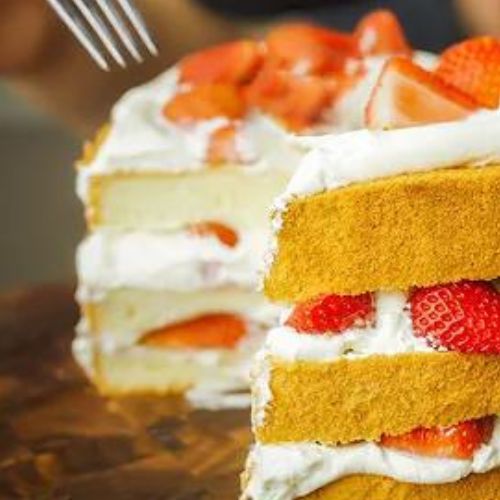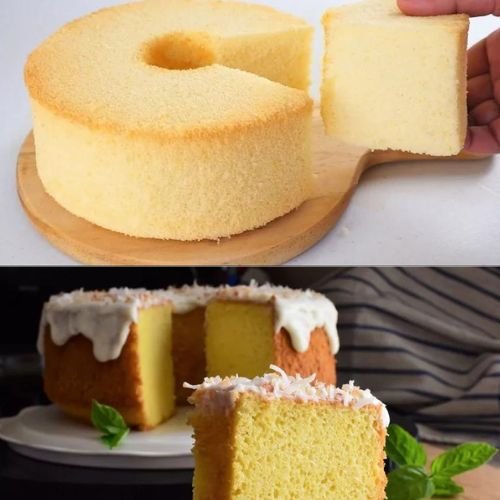Have you ever bitten into a slice of chiffon cake and marveled at its incredibly light, airy texture? It’s like biting into a cloud, isn’t it?
But have you ever wondered about the science behind this heavenly dessert?
Today, I’m diving deep into the world of chiffon cakes to answer a question that’s been puzzling bakers and cake enthusiasts alike: Is chiffon cake shortened or unshortened?

Buckle up, because we’re about to embark on a delicious journey of culinary discovery!
Understanding Cake Terminology: Shortened vs. Unshortened
Before we can tackle our main question, we need to get our baking vocabulary straight. What exactly do we mean when we talk about “shortened” and “unshortened” cakes? Let’s break it down.
What Does “Shortened” Mean in Baking?
In the baking world, “shortened” doesn’t mean your cake got a haircut. It refers to the presence of fat that’s been added to “shorten” or tenderize the gluten strands in the flour.
This fat is usually in the form of butter, margarine, or shortening. Shortened cakes tend to be richer and more tender, with a softer crumb.
The Concept of “Unshortened” Cakes
On the flip side, “unshortened” cakes are those made without added fat or with very little fat. These cakes rely on whipped eggs for their structure and texture.
They’re typically lighter and spongier than their shortened counterparts.
The Origins of Chiffon Cake: A Brief History
Now that we’ve got our terms straight, let’s take a quick trip down memory lane. Chiffon cake isn’t some centuries-old recipe passed down through generations. In fact, it’s a relatively modern invention!
The chiffon cake was created in 1927 by Harry Baker, a California insurance salesman turned caterer.
For years, Baker kept his recipe a closely guarded secret, selling cakes to Hollywood stars and fancy Brown Derby restaurants. It wasn’t until 1947 that he sold the recipe to General Mills, who popularized it through Betty Crocker.
Ingredients that Make Chiffon Cake Special
So, what’s in this magical cake that makes it so unique? Let’s peek into the mixing bowl and find out.
The Role of Oil in Chiffon Cake
Here’s where things get interesting. Unlike traditional butter cakes, chiffon cake uses vegetable oil as its fat source. “But wait,” you might say, “doesn’t that make it a shortened cake?” Not so fast! The oil in chiffon cake plays a different role than butter in a typical shortened cake.
Egg Whites: The Key to Lightness
The real star of the show in chiffon cake is the egg whites. They’re whipped to stiff peaks and then gently folded into the batter, creating that signature airy texture we all know and love.
Other Essential Ingredients
Rounding out the ingredient list are flour, sugar, baking powder, and egg yolks. Some recipes also include cream of tartar to stabilize the egg whites.
The Chiffon Cake Baking Process
Now that we know what goes into a chiffon cake, let’s talk about how it all comes together.
Mixing Techniques for Perfect Texture
The mixing process for chiffon cake is a bit like conducting an orchestra. Each section has its part to play, and timing is everything.
The dry ingredients are mixed with the oil and egg yolks to form a smooth batter. Meanwhile, the egg whites are whipped to stiff peaks with sugar.
The Importance of Proper Folding
Here’s where the magic happens. The fluffy egg whites are gently folded into the batter, creating a light, airy mixture. This step is crucial – overmix, and you’ll deflate those precious air bubbles!
Chiffon Cake vs. Other Cake Types
To really understand what makes chiffon cake special, it helps to compare it to its cakey cousins.
Comparing Chiffon to Sponge Cake
Sponge cakes and chiffon cakes are both light and airy, but there’s a key difference. Sponge cakes typically use butter or no fat at all, while chiffon cakes use oil.
How Chiffon Differs from Butter Cake
Butter cakes are the classic “shortened” cakes. They’re denser and richer than chiffon cakes, thanks to the butter that’s creamed with sugar at the start of the mixing process.
The Unique Texture of Chiffon Cake
All these ingredients and techniques come together to create chiffon cake’s one-of-a-kind texture. It’s incredibly light and fluffy, yet moist at the same time. It has a springy quality that makes it a joy to eat.
Nutritional Aspects of Chiffon Cake
Now, I know what you’re thinking – is chiffon cake healthy? Well, let’s not kid ourselves – it’s still cake. But compared to many other cakes, it’s relatively light. The use of oil instead of butter means it’s lower in saturated fat, and all those eggs provide some protein.
Versatility in Flavors and Decorations
One of the best things about chiffon cake is how versatile it is. The basic recipe can be tweaked to create all sorts of flavors – lemon, orange, chocolate, even matcha!
And when it comes to decorating, the sky’s the limit. Its sturdy yet light texture makes it perfect for layering and frosting.
Tips for Baking the Perfect Chiffon Cake
Ready to try your hand at baking a chiffon cake? Here are some pro tips:
- Make sure your eggs are at room temperature for maximum volume.
- Be gentle when folding in the egg whites – you want to keep as much air in the batter as possible.
- Use a tube pan for best results, and don’t grease it! The cake needs to cling to the sides as it rises.
- Cool the cake upside down to prevent it from collapsing.
Common Mistakes to Avoid
Even experienced bakers can run into trouble with chiffon cake. Here are some common pitfalls to watch out for:
- Overmixing the batter, which can lead to a tough cake
- Not whipping the egg whites enough (or whipping them too much)
- Opening the oven door too early, causing the cake to sink
- Trying to remove the cake from the pan while it’s still warm
Conclusion: The Unshortened Marvel of Chiffon Cake
So, after all this, we come back to our original question: Is chiffon cake shortened or unshortened? The answer is… it’s a bit of both! While it does contain fat in the form of oil, chiffon cake relies primarily on the structure provided by whipped egg whites, much like an unshortened cake. This unique combination is what gives chiffon cake its characteristic texture – light and airy, yet moist and tender.
Chiffon cake truly represents the best of both worlds. It has the richness and moisture of a shortened cake, thanks to the oil, but the lightness and sponginess of an unshortened cake, courtesy of those whipped egg whites. It’s a testament to the ingenuity of bakers like Harry Baker, who aren’t afraid to think outside the box (or the cake pan, in this case).
So the next time you sink your teeth into a slice of chiffon cake, take a moment to appreciate the culinary marvel you’re enjoying. It’s not just a cake – it’s a perfect balance of science and art, a delicious example of how breaking the rules can sometimes lead to something extraordinary.
FAQs
- Can I use butter instead of oil in a chiffon cake? While you technically can, it’s not recommended. Oil helps keep the cake moist and maintains its light texture better than butter would.
- Why does my chiffon cake always collapse after baking? This is often due to cooling the cake right-side up. Always cool chiffon cakes upside down to maintain their structure.
- Is chiffon cake the same as angel food cake? While they’re similar, angel food cake uses only egg whites and no fat at all, whereas chiffon cake includes both egg yolks and oil.
- Can I make chiffon cake without a tube pan? A tube pan is ideal, but you can use a regular round pan. Just be aware that the texture and rise might be slightly different.
- How long does chiffon cake stay fresh? When stored properly in an airtight container, chiffon cake can stay fresh for 3-4 days at room temperature, or up to a week in the refrigerator.
